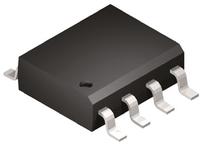下载

Semiconductor Components Industries, LLC, 2004
July, 2004 − Rev. 2
1 Publication Order Number:
AND8156/D
AND8156/D
NUD4001 and NUD4011
Low Cost Integrated
Current Sources for LEDS
Lighting Applications of
Low and High Voltage
(6.0 V − 120 V)
Prepared by: Alejandro Lara and Mike Girand
ON Semiconductor
ABSTRACT
The increasing usage of Light Emitting Diodes (LEDs) to
address different lighting applications such as traffic
signals, exit signs, backlighting and general illumination
have made them very popular to the point where they are
now an attractive choice for all those lighting applications
that were once the domain of incandescent lamps. LEDs
have several advantages when compared with incandescent
lamps. They offer fast turn−on, lower heat generation, lower
power consumption, higher operating life, and high
resistance to shock/vibration. Nevertheless, LEDs need to be
driven properly to ensure optimal performance and long life.
Designing and implementing an effective driver is key to
obtain all the benefits of LEDs. The driver’s implementation
must be cost effective, which is not usually achieved with
discrete components but with integrated solutions.
INTRODUCTION
LEDs are created from various doped semiconductor
materials in the form of a P−N diode junction. When
electrical current flows through the junction in the forward
direction, the electrical carriers deliver energy proportional
to the forward voltage drop across the diode junction, which
is emitted in the form of light. The amount of energy is
relatively low for low current (< 30 mA) infrared or red
LEDs. However, for green and blue LEDs which are
manufactured from higher forward voltage materials, the
amount of energy is greater.
The conversion efficiency of electrical energy into light
energy is very important. Today’s LEDs vary between 10
and 20 percent efficiency. The rest of the energy is converted
to heat. This heat must be effectively dissipated, as the
operating junction temperature of the LED die must be
maintained no higher than +125°C.
Since the device is being used in the forward biased mode,
once the voltage applied exceeds the diode forward voltage;
the current through the device can rise exponentially. Very
high currents would damage the LEDs, so this is why
electronic drivers must be added when LEDs are driven
from any voltage source. The amount of light emitted by an
LED is proportional to the amount of average current
flowing through the device in the forward bias direction. As
the current is varied, the output of the light will vary in a
similar way. Therefore, a Light−Emitting Diode (LED) is
essentially a PN junction semiconductor diode that emits
light when current is applied.
By definition, it is a solid−state device that controls
current without heated filaments and is therefore very
reliable. LEDs have special characteristics that assure high
reliability and compatibility with electronic drive circuits.
LEDs have advantages and disadvantages when
compared with other light sources such as incandescent or
fluorescent lamps. The most significant advantages are fast
turn−on, lower heat generation, lower power consumption,
longer operating life, and high resistance to shock/vibration.
Some of the disadvantages are the narrow viewing angle,
near monochromatic light, limited wavelength selection,
and they require electronic drive circuits for operation.
LEDs, regardless of color, have an extremely long
lifetime, whenever their current and temperature limits are
not exceeded.
Lumileds Lighting LLC [1, 2] has published lifetime
data stating that after 50,000 hours the LEDs will have 70
percent or greater of the original light output. Using an
engineering rule of thumb with data already collected and
plotted on a semi−log graph paper, LEDs are projected to
have 50 percent or greater of the original light output after
100,000 hours. This is approximately 11 years and 5 months
of continuous service with light greater than 50 percent of
the initial output. Remember, in order to obtain maximum
life, the LEDs must be operated within the manufacturers
specified limits of both current and diode junction
temperature. LEDs should be used where extremely long
life is desired and the cost of lamp replacement is very high.
APPLICATION NOTE
http://onsemi.com








